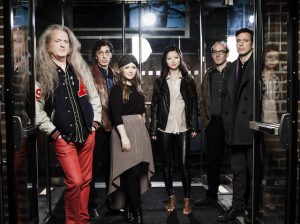Bang on a Can All-Stars
Play Brian Eno’s ‘Music for Airports’
MASS MoCA
North Adams, Mass.
Saturday, July 23, 2016
Review by Seth Rogovoy
(NORTH ADAMS, Mass., July 23, 2016) – Bang on a Can first performed Brian Eno’s landmark work, “Music for Airports,” live at MASS MoCA as part of its annual Summer Music Festival, in the summer of 2005. Eleven years to the very day, this past Saturday night, the Bang on a Can All-Stars gave an encore performance of the piece, opened up by the addition of music fellows from Bang on a Can’s summer institute, both instrumentalists and vocalists. Still, the piece for the most part retained its intimate, minimal qualities, and its precision of rhythms and tones.
Much of what I wrote about that 2005 concert still rings true today, and I won’t bother repeating myself other than perhaps to say that by now, Bang on a Can has certainly made a strong case for “Music for Airports” – originally conceived by Eno as ambient music not meant to be performed live but rather as a recording to be used functionally – to be made part of the contemporary repertoire. Playing this music presents the sort of challenges that must be as thrilling for musicians themselves as they are for listeners, especially in the first movement, when tones seem to follow each other like dominos yet with an ever-shifting substratum of “rhythm,” such as there is to be found in this piece that seemingly defies any regular time signature without being too disorienting.
That gorgeous first movement, arranged by Bang on a Can cofounder and composer Michael Gordon, benefits from the dimensionality and breath added by the live performance, especially in the playing of cellist Ashley Bathgate, whose impossibly long glissandi sounded almost like a note hanging around so long that it decayed and fell. Gordon and the players here gave the piece just a hint of more drama, shape, an arc with even a hint of crescendo more than what exists in the original. Pianist Vicky Chow also was a standout here – her timing was essential to the piece’s success, as she sort of tipped the dominos with each phrase. While Bang on a Can did transcribe this work, for which no written music existed, one still imagines that much of it is played by ear, otherwise it would toy dangerously with a musical pileup of notes.
Bang cofounder David Lang’s arrangement of the second movement (or, the second movement of the first half, depending on how you are counting), which mostly relies on the human voice, is a stunning re-creation of the original, and how he was able to divine how individual voices would combine to create the same mass-chorus impressionistic effect that recalls the choral style of Gyorgy Ligeti, is striking. The chorus here, consisting of institute fellows who primarily are not in residence as vocalists but rather as instrumentalists and composers, gave this challenge a great effort, but didn’t always succeed, with occasional missed entrances, pitch problems, and a general lack of precision that the score requires.
The third movement (or first movement of the second half), arranged by Bang cofounder Julia Wolfe, relied on both musicians and choir, and the choir was definitely helped by having the musicians lead the way. The final movement, arranged by former Bang member Evan Ziporyn, took the most liberties, putting more of a Bang on a Can stamp on the piece after the previous movements stuck closely to the original. Ziporyn gave more license to a few of the lead musicians – here most notably clarinetist Ken Thomson, percussionist David Cossin, and guitarist Mark Stewart – to express themselves with an original tone and even some elements of improvisation. I was less concerned by the improvisations than by the reliance by on vibrato that I felt was not in keeping with the crisp, taut spirit of Eno’s original.
Saturday night’s program also included four recent entries in Bang’s ongoing “Field Recordings” series, in which Bang on a Can asks composers to combine archival audio, found sound and/or video, and combine it with something of their own making, in order to “build a bridge between the seen and the unseen, the present and absent, and the past and the future.”
The highlight was Pulitzer Prize-winning composer Caroline Shaw’s “Really Craft When You,” which juxtaposed archival interviews of quilters from Virginia and North Carolina, conducted in the 1970s, describing their work and process. The connection to Shaw’s “quilting squares of music” she provided for the All-Stars to stitch together was clear in the quilters’ talk about design, patterns, repetitions, and harmony – they could well have been describing contemporary music.

